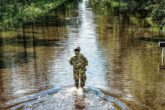May 10, 2022
Risk and Responsibility
Managing Future Iranian Weapons of Mass Destruction Threats
Executive Summary
Washington is reimagining its global role, leading the U.S. Department of Defense (DoD) to make difficult choices about priorities, resources, and risk to better address the long-term “pacing challenge” posed by China. To do so, the United States plans to accept risks in the Middle East and against future Iran threats. Iran’s possession and potential use of weapons of mass destruction (WMDs)—specifically, its nuclear program, chemical weapons, and biological agents—pose the greatest threat to U.S. interests and Washington’s ability to accept risk in the region. But how Iran might leverage WMDs to threaten U.S. interests and upend Washington’s plans to make trade-offs in global responsibilities is unclear, while the risks of failing to address these challenges remain high. As a result, the DoD and its component organizations, such as the Defense Threat Reduction Agency (DTRA), must enhance their understanding of the threat posed by Iran’s nuclear, chemical, and biological capabilities and the escalation dynamics surrounding Iranian WMDs during crisis and conflict. By doing so, the United States can better accept risk in the Middle East and revise its global priorities while still protecting core U.S. interests.
To improve the DoD’s understanding of future Iranian WMD-related threats and escalation dynamics, the Gaming Lab at the Center for a New American Security (CNAS) conducted a series of three virtual strategic-operational tabletop exercises (TTXs) exploring future Iranian nuclear, chemical, and biological weapons use. The TTXs indicated that even if Iran acquires a nuclear weapon, the likelihood the regime will use it is low. Instead, the regime may be more likely to use chemical and biological weapons to escalate conflict. Moreover, there are significant asymmetries between American and Iranian views of conflict timelines, escalation redlines, and risk tolerance, all of which make it difficult to offer and signal credible ways to de-escalate a crisis. Differences between Washington’s risk acceptance and that of its regional partners—Israel, in particular—further complicate U.S.-Iran interactions.
The TTXs aimed to enable the United States to identify where and how it might mitigate the risk it must accept to better marshal resources in support of the department’s strategic guidance. Accepting greater risk against Iran and in the Middle East more broadly means shifting U.S. strategic priorities in the region. This shift has the potential to unsettle allies and partners, and may possibly embolden Iran in the near term, but such tough choices must be made if the United States wishes to prioritize other long-term threats that may be of greater impact to U.S. security, such as China.
Introduction
The United States is at a critical juncture in its defense policy. An increasingly multipolar world has given rise to an array of challenges, leading the United States to reimagine its global role and pushing the U.S. Department of Defense (DoD) and its component organizations to make difficult choices about priorities, resources, and risk to meet current and future threats more effectively. Long-term competition with China stands at the forefront of these challenges, as Beijing’s rapid military modernization and nuclear expansion threaten U.S. military dominance. But other threats in the form of Russia, an acute threat, nuclear-aspirant states such as Iran, and transnational threats such as COVID-19 and climate change also require attention.1 Balancing global responsibilities with China as the “pacing challenge” while contending with constrained resources and attention is difficult. For the DoD to prioritize China and the Indo-Pacific region in its defense strategy, it will need to accept risk against other threats and in other regions.2
The Interim National Security Strategic Guidance and other strategic documents indicate that Washington plans to accept risk in the Middle East and against Iran.3 Taking risk in the Middle East requires not only “right- sizing” U.S. presence in the region4 but also hedging against potential Iranian conventional and nuclear aggression.5 But in order for the United States to accept risk, it first must understand what the specific risks are. In addition to conventional and terrorism-related Iranian threats, Iranian weapons of mass destruction (WMDs— specifically, its nuclear program, chemical weapons, and biological agents6—pose a unique threat to U.S. interests. Therefore, developing an increased understanding of the potential future risks that Iranian WMDs pose is required for Washington to assess risk globally, identify where it can make trade-offs, and mitigate additional risk resulting from those trade-offs.7
Successive U.S. administrations have identified Iran as a national security challenge given its nuclear aspirations and continued support for militant groups targeting U.S. military forces and regional allies and partners.8 Tehran has long developed asymmetric and nuclear capabilities to make up for its conventional inferiority vis-à-vis the United States, Israel, and other Middle Eastern states.9 These include its pursuit of a nuclear capability; its building of a sizable arsenal of short-, medium-, and long-range ballistic and cruise missiles capable of carrying WMDs; and its network of nonstate armed groups that are supported by and allied with the Iranian regime.10 Together, these capabilities give the Iranian regime the ability to strike adversaries by proxy with outward deniability and deter aggression against Iranian territory, all while imposing costs on the United States and its regional allies and partners.
Taking risk in the Middle East requires not only “rightsizing” U.S. presence in the region but also hedging against potential Iranian conventional and nuclear aggression.
Already, Iran has demonstrated its ability to threaten U.S. forces, undermine regional stability, and affect global commerce. In January 2020, Iran’s Islamic Revolutionary Guard Corps (IRGC) precisely hit al-Asad Air Base in Iraq with more than 10 ballistic missiles in retaliation for the targeted killing of IRGC commander Qasem Soleimani, wounding several U.S. service members.11 Similarly, in September 2019, the Iranian regime launched a drone and cruise missile attack on Saudi Aramco facilities in Abqaiq and Khurais to cripple global oil production.12 Despite Iran’s comparative conventional inferiority, these two examples demonstrate the advancement and sophistication of Iran’s conventional capabilities, capacity to incorporate its proxy groups and new technologies into attacks, and ability to implement new tactics.13 Rocket attacks on U.S. forces from Iranian-aligned militias continue almost daily in Iraq, while Iran’s broad network of proxy groups continues to attack U.S. regional partners and advance Iran’s use of gray zone tactics to achieve strategic aims.
Moreover, Iran’s recent progress on its nuclear enrichment program has advanced its ability to produce weapons-grade uranium, reducing its timeline to develop a nuclear weapon and creating more uncertainty around the nature of its nuclear program.14 As negotiations to return to the Joint Comprehensive Plan of Action (JCPOA) appear to be faltering, putting the brakes on Iran’s program looks less likely and a nuclear-capable Iran appears to be a greater possibility.15 Iran’s history of chemical and biological programs was most alarming in the 1990s after the Iran-Iraq war. Credible assessments in the last decade or so are more mixed, with less information available.16 The future threat that Iranian WMDs may pose is compounded by the nuclear program’s trajectory; the country’s continued possession of chemical and biological weapons; the growing level of complexity, accuracy, and sophistication of attacks; and Iran’s expanding missile capabilities.
It is therefore imperative for the DoD, and in particular the Defense Threat Reduction Agency (DTRA), a DoD defense and combat support agency charged with countering and deterring WMD threats, to understand the potential threat posed by Iran’s nuclear, chemical, and biological capabilities and the escalation dynamics surrounding Iranian WMDs during crisis and conflict. As the DoD is currently determining trade-offs in its global responsibilities, it is necessary for the department and its component organizations to understand Iran’s potential thresholds for future WMD use to better recognize the circumstances that may merit a U.S. response and thus shift required resources and attention to the Middle East. Increased understanding of Iranian WMD thresholds will also help the DoD determine how it can effectively manage escalation and enhance deterrence in potential future scenarios in which Iran uses WMDs—including nuclear weapons. In so doing, the United States can better accept risk in the Middle East and revise its global priorities while still protecting core U.S. interests.17
Increased understanding of Iranian WMD thresholds will also help the DoD determine how it can effectively manage escalation and enhance deterrence in potential future scenarios in which Iran uses WMDs—including nuclear weapons.
To enhance DTRA’s understanding of future Iranian WMD threats and improve the agency’s ability to advocate a course of action to the DoD, interagency stakeholders, and U.S. allies and partners, the Gaming Lab at the CNAS conducted a series of three virtual strategic-operational tabletop exercises (TTXs) in the fall of 2021, using scenarios in which Iran possessed advanced nuclear, chemical, and biological capabilities. The TTXs aimed to enhance understanding of Iranian WMD threats and escalation dynamics to enable the United States to identify where and how it may mitigate the risk it must accept to better marshal resources in support of the department’s strategic guidance. Several insights emerged from the TTX series that help inform why, when, and how Iran could employ WMDs in future scenarios to challenge U.S. interests and identify options for ways the United States can best manage this threat.
This report first provides a brief overview of the TTX series. Next, it details insights about future Iranian WMD threats and escalation derived from the three TTXs. It concludes with recommendations drawn from these insights, aimed at improving DTRA’s understanding of the risks related to future Iranian WMD as well as its ability to advocate for DoD and whole-of-government strategies that appropriately address and mitigate such risks.
Download the Full Report.
- Stacie Pettyjohn, Becca Wasser, and Jennie Matuschak, “Risky Business: Future Strategy Force Options for the Defense Department,” (Center for a New American Secu- rity, July 20, 2021), https://www.cnas.org/publications/reports/risky-business-future-strategy-and-force-options-for-the-defense-department. ↩
- Dr. Mara Karlin, Performing the Duties of Deputy Under Secretary of Defense for Policy, “Mission Brief: The Next National Defense Strategy with Dr. Mara Karlin,” Mission Brief speaker series, Center for a New American Security, December 9, 2021, https://www.cnas.org/events/mission-brief-the-next-national-defense-strategy-with-dr-mara-karlin. ↩
- The White House, Interim National Security Strategic Guidance (March 2021), https://www.whitehouse.gov/wp-content/uploads/2021/03/NSC-1v2.pdf; Defense Threat Reduction Agency, Defense Threat Reduction Agen- cy Strategy: Fiscal Year 2022–2027 (2022), https://www.dtra.mil/Portals/61/Documents/DTRA_Strategy_2022.pdf; and “Secretary Lloyd J. Austin III Message to the Force,” Department of Defense, March 4, 2021, https://media.defense.gov/2021/Mar/04/2002593656/-1/-1/0/SECRETARY-LLOYD-J-AUSTIN-III-MESSAGE-TO-THE-FORCE.PDF. ↩
- Ilan Goldenberg, Becca Wasser, Elisa Catalano Ewers, and Lilly Blumenthal, “When Less Is More: Rethinking U.S. Military Strategy and Posture in the Middle East” (Center for a New American Security, November 4, 2021), https://www.cnas.org/publications/reports/when-less-is-more. ↩
- Defense Threat Reduction Agency, Defense Threat Reduction Agency Strategy: Fiscal Year 2022–2027; “Secretary Lloyd J. Austin Message to the Force.” ↩
- Defense Threat Reduction Agency, Defense Threat Reduction Agency Strategy: Fiscal Year 2022–2027. ↩
- “Secretary Lloyd J. Austin Message to the Force.” ↩
- Secretary of Defense Lloyd J. Austin III, “Remarks by the Secretary of Defense Lloyd J. Austin III on Middle East Security at the Manama Dialogue (As Delivered),” (Manama, Bahrain, November 20, 2021), https://www.defense.gov/News/Speeches/Speech/Article/2849921/remarks-by-secretary-of-defense-lloyd-j-austin-iii-on-middle-east-security-at-t/source/remarks-by-secretary-of-defense-lloyd-j-austin-iii-on-middle-east-security-at-t/; The White House, Interim National Security Strategic Guidance; Defense Intelligence Agency, Iran Military Power: En- suring Regime Survival and Securing Regional Dominance (August 2019), https://www.dia.mil/Portals/110/Images/News/Military_Powers_Publications/Iran_Military_Power_LR.pdf; “Statement by Secretary of Defense Dr. Mark T. Esper As Prepared,” Department of Defense, January 2, 2020, https://www.defense.gov/News/Releases/Release/Article/2049227/statement-by-secretary-of-defense-dr-mark-t-esper-as-prepared/; “Remarks by Secretary Mattis on National Defense Strategy,” Department of Defense, December 1, 2018, https://www.defense.gov/News/Transcripts/Transcript/Article/1702965/remarks-by-secretary-mattis-on-national-defense-strategy/; and “Statement by Secretary of Defense Ash Carter on the Iran Deal,” Department of Defense, July 14, 2015, https://www.defense.gov/News/Releases/Release/Article/612779/. ↩
- Michael Connell, “Iran’s Military Doctrine,” The Iran Primer, the United States Institute of Peace, October 11, 2010, https://iranprimer.usip.org/resource/irans-military-doctrine. ↩
- Michael Elleman, “Iran’s Missiles: Evolution and Arsenal,” The Iran Primer, the United States Institute of Peace, January 15, 2021, https://iranprimer.usip.org/blog/2021/jan/15/biden-iran-missile-program; Defense Intelligence Agency, Iran Military Power: Ensuring Regime Survival and Securing Regional Dominance; Ariane M. Tabatabai, “Iran’s National Security Debate: Implications for Future U.S.-Iran Negotiations” (RAND Corporation, October 2019), 8–11; and Ariane Tabatabai, Jeffrey Martini, and Becca Wasser, “The Iran Threat Network (ITN): Four Models of Iran’s Nonstate Client Partnerships,” (RAND Corporation, 2021). ↩
- Alissa J. Rubin, Farnaz Fassihi, Eric Schmitt, and Vivian Yee, “Iran Fires on U.S. Forces at 2 Bases in Iraq, Calling It ‘Fierce Revenge,’” The New York Times, January 7, 2020, https://www.nytimes.com/2020/01/07/world/middleeast/iran-fires-missiles-us.html. ↩
- Louisa Loveluck and Mustafa Salim, “Iraqi Prime Minister’s residence targeted by drone strike, military says,” The Washington Post, November 6, 2021, https://www.washingtonpost.com/world/drone-hits-iraqi-pm-house/2021/11/06/248a4b4a-3f61-11ec-bd6f-da376f47304e_story.html; “Barrage of rockets fired at airbase housing US troops in Iraq,” Al Jazeera, July 7, 2021, https://www.aljazeera.com/news/2021/7/7/barrage-of-rockets-fired-at-airbase-housing-us-troops-in-iraq; and Ben Hubbard, Palko Karasz, and Stanley Reed, “Two Major Saudi Oil Installations Hit by Drone Strike, and U.S. Blames Iran,” The New York Times, September 14, 2019, https://www.nytimes.com/2019/09/14/world/middleeast/saudi-arabia-refineries-drone-attack.html. ↩
- Jane Arraf and Eric Schmitt, “Iran’s Proxies in Iraq Threaten U.S. With More Sophisticated Weapons, The New York Times, June 4, 2021, https://www.nytimes.com/2021/06/04/world/middleeast/iran-drones-iraq.html?smid=tw-share; Liz Sly, “Iran’s role in attack on U.S. troops in Syria signals new escalation,” The Washington Post, October 26, 2021, https://www.washingtonpost.com/world/iran-militias-tanf-us-forces/2021/10/26/8c75ad98-35c1-11ec-9662-399cfa75efee_story.html; and Patrick Kingsley and Ronen Berg- man, “Israeli Officials Say Iran Is Behind Deadly Attack on Oil Tanker,” The New York Times, July 30, 2021, https://www.nytimes.com/2021/07/30/world/middleeast/tanker-attack-oman.html. ↩
- Eric Brewer, “Iran’s Evolving Nuclear Program and Implications for U.S. Policy” (Center for Strategic and International Studies, October 15, 2021), https://www.csis.org/analysis/irans-evolving-nuclear-program-and-implications-us-policy. ↩
- Laurence Norman, “Iran Nuclear Talks Stall as Tehran Toughens Stance,” The Wall Street Journal, December 3, 2021, https://www.wsj.com/articles/talks-to-restore-iran-nuclear-deal-stall-11638538912. ↩
- “Iran Chemical Overview,” Nuclear Threat Initiative, January 23, 2020, https://www.nti.org/analysis/articles/iran-chemical/. ↩
- Goldenberg, Wasser, Ewers, and Blumenthal, “When Less Is More: Rethinking U.S. Military Strategy and Posture in the Middle East.” ↩
More from CNAS
-
From Production Lines to Front Lines
Executive Summary The U.S. defense industrial base (DIB) is struggling to meet the demands of the current strategic environment—let alone prepare for a potential conflict agai...
By Becca Wasser & Philip Sheers
-
More than the Sum of its Parts: Developing a Coordinated U.S.-Australian Response to Potential Chinese Aggression
If China engaged in a war of aggression, the United States, Australia, and other nations would not have much time to develop a coordinated response....
By Stacie Pettyjohn
-
It’s Time for a True Industrial Strategy for American National Security
For an industrial strategy to work, the president must make it a White House priority that pulls together all elements of national power....
By Becca Wasser & Mara Rudman
-
How We Survive Ep 5: Wargames
Dr. Ed McGrady, Adjunct Senior Fellow for the Defense Program at CNAS, joins the show to discuss how climate began to factor into humanitarian crisis war games as far back as ...
By Dr. ED McGrady






